Tankless (Demand) Water Heaters
Installation Case Study with Photos, Commentary, and Payback Calculator
In May, 2006, we replaced our two gas, tanked water heaters with two gas tankless (a.k.a. "demand," or "instantaneous") heaters. We had two heaters because our home is a large ranch style. One heater supplied the bedroom area and the other served the kitchen sink, dish washer, and laundry. These old heaters were 12 years old. At the time of replacement, we also added two electric tankless heaters to supply sinks that were located a long way from the gas heaters. This was to reduce the time to get hot water at those faucets. So, let's count -- now we have four tankless water heaters.
Tankless heaters are more expensive than tanked heaters because they are more complex.
But, the gas-fired units are more efficient and cost less to run.
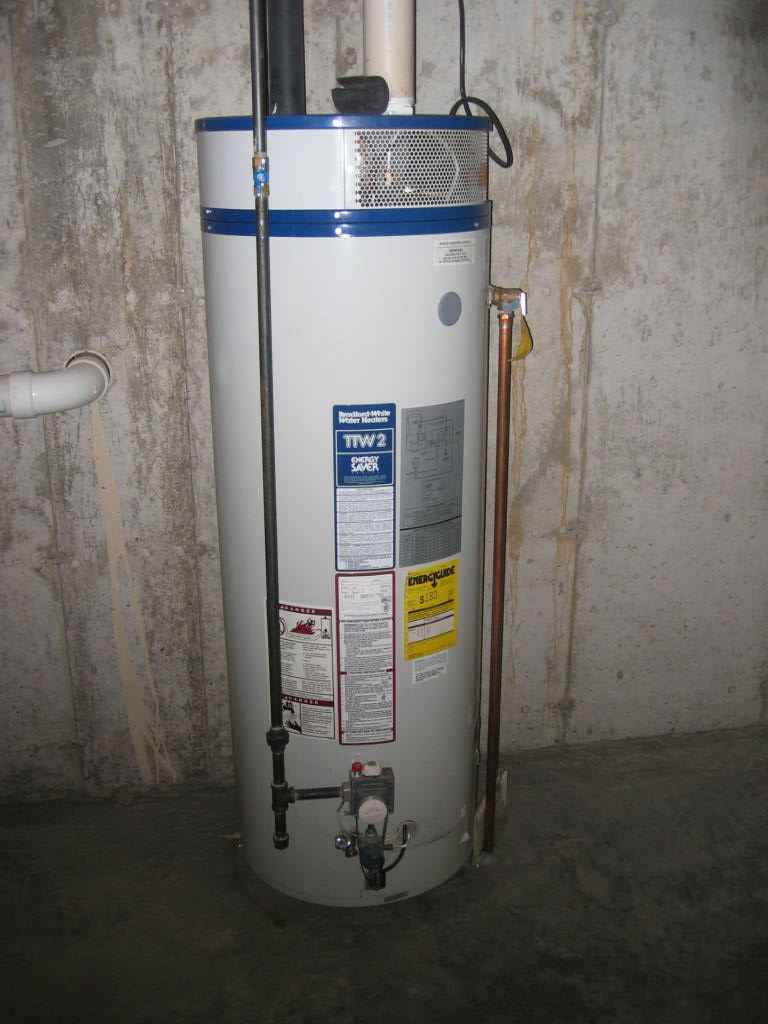
Old gas tanked water heater #1 (bedrooms)

New gas tankless water heater #1 (bedrooms)
Rinnai 2520 FFU
Notice that the hot water pipe is mostly 1.25-inch diameter. See the discussion about hot water delays, below.
The yellow pipe is the gas supply.
The temperature control uses a two-wire, low-voltage cable, so it could easily be moved to an upstairs location. (See detail photo, below.)
This unit serves three showers, two sinks, and a laundry. It works fine even if all three showers are in use.

Old gas tanked water heater #2 (kitchen)
(Not shown: dead mouse under heater)

New gas tankless water heater #2 (kitchen)
Rinnai 2520 FFU
When you turn off your faucet, the burners extinguish immediately, but the exhaust fan continues to operate for a minute or two.
I designed a remote burner indicator for use near our kitchen sink. It consists of an IR detector poked into the viewing window, a Darlington amplifier circuit wired to an X10 transmitter, and a remote indicator connected to an X10 lamp module (photos below). This allows us to know if the flow rate is high enough to turn the heater on (preventing the water from unexpectedly going cold).
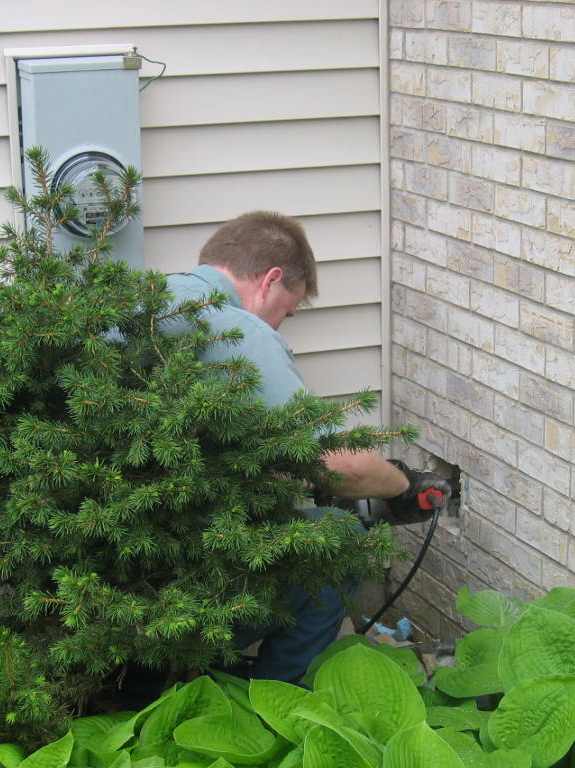
Installing a new vent pipe.
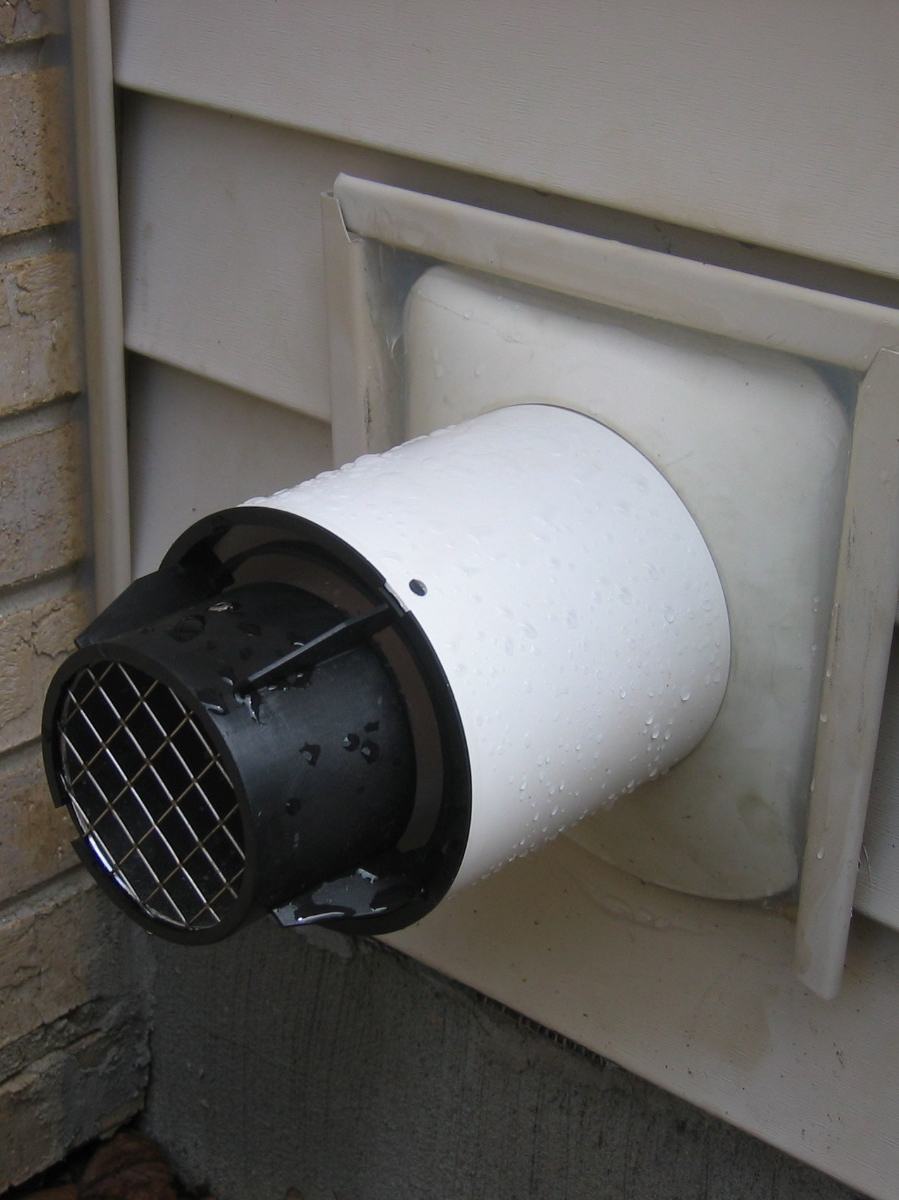
Fresh air goes in around the rim and exhaust air comes out through the center.
Our old tanked heaters would continue to heat for a long time after running a shower. The exhaust fan would cause annoying vibrations which were perceptible in the bedroom area. The tankless heaters shut off immediately when the water flow stops and the fan continues to run for only a short time. (The electric heaters are completely silent.)
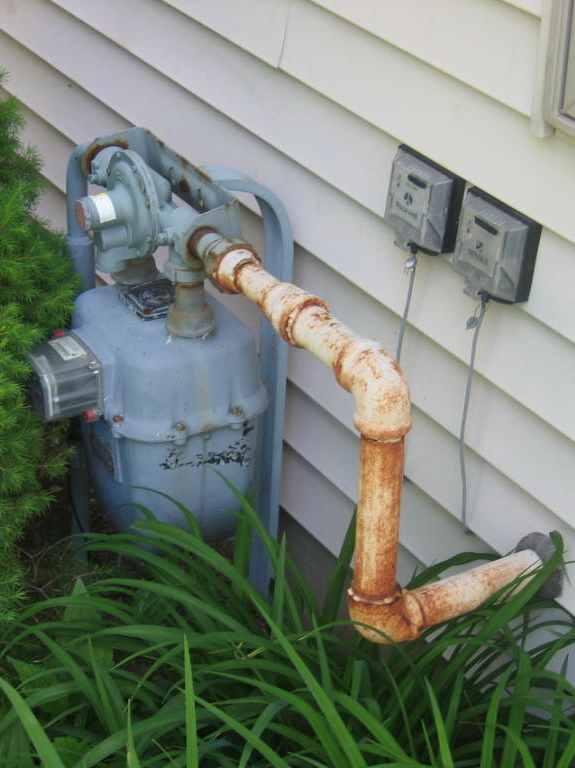
Original gas meter and regulator (1/2 lb)
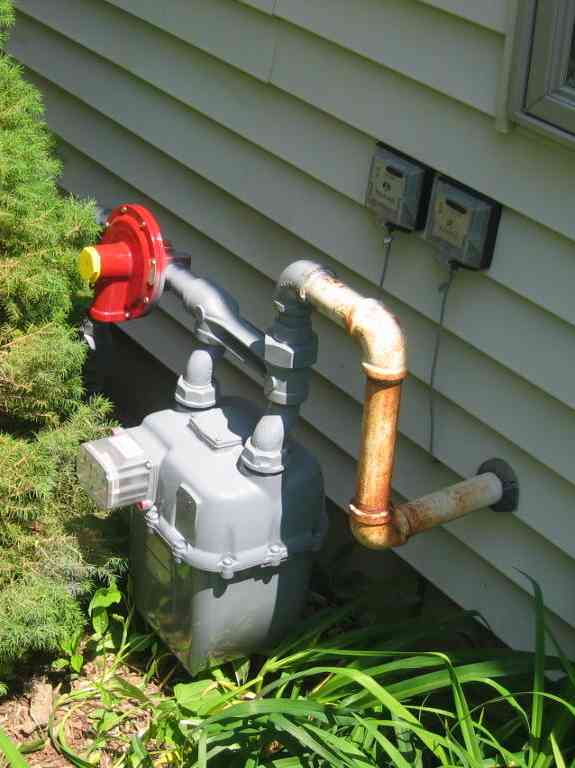
New gas meter and regulator (2 lbs)
Our other gas appliances are two furnaces and a gas fireplace.

New electric tankless water heater #3
(located under the powder room sink)
Stiebel Eltron DHC 3-1

New electric tankless water heater #4
(located under the two master bathroom sinks)
Stiebel Eltron DHC 3-1
We installed these units for convenience only: to decrease the wait time for hot water at the faucets. We'll never recover our investment (unless it increases the value of our home).
These photos show our electric heaters when they were mounted in the basement, directly under the sinks. Such heaters are usually mounted in a cabinet closer to the faucet -- and that's where we relocated them a few years later to reduce the wait time.

Rinnai 2520 FFU Internals
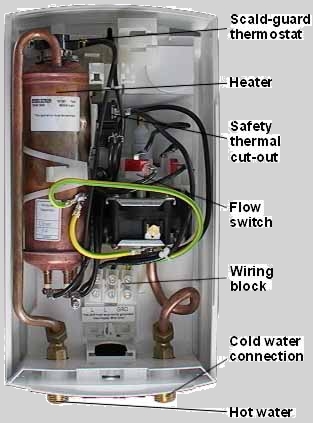
Stiebel Eltron DHC-1 Internals
If you're not prepared for this, you'll try to compensate by adjusting your faucet, causing yet more temperature fluctuations. And there's a minimum flow rate, below which the heater will turn off (but you won't know it until the water starts to run cold).
This was the reason I wired up a remote burner indicator as mentioned above (photos below). Rinnai's remote control does not indicate burner state.
Specifications:
Hot water capacity (50 deg-F rise): 0.6 to 5.3 gal/min
Temperature control: variable flame (automatic)
Maximum temperature setting: 140 deg-F
Efficiency rating: 87%
Specs (PDF)
Specifications:
Hot water capacity (65 deg-F rise): 0.32 gal/min
Hot water capacity (49 deg-F rise): 0.42 gal/min
Temperature control: water flow rate (manual)
Maximum temperature setting: depends on flow rate
Efficiency rating: n/a (used to reduce time, not costs)
Specs (PDF)

Rannai's temperature control panel
How to compute the payback period when installing a tankless water heater instead of a tanked heater:
- Compute your annual energy cost had you used a tanked water heater, then deduct the annual energy cost of using a tankless water heater. This is your energy cost savings per year.
- Compute the differential installation costs. Take the installation costs of the tankless heater and subtract the costs had you simply replaced your old (tanked) heater. This is the amount you need to recover.
- Compute the payback period by dividing the amount you need to recover (step 2) by the energy cost savings per year (step 1).
- If you're planning to sell your home in the near future, you can also account for the increased resale value a tankless heater affords. Do this by deducting the increased value from the amount to be recovered.
The calculator below will get you started on figuring your payback period. You'll need to measure water flow rates. There are two ways to do this.
- Place a bucket under the faucet. Let the faucet run normally for one minute, then use a measuring jar to determine the amount of water delivered.
- Visit your water meter both before and after running the faucet, and compute the difference in the readings.
In both cases, you are measuring the total water flow. This includes unheated cold water, but we correct for this by using the mixed, warm water temperature to compute the energy required. If you are able to measure only the hot water consumption (you installed a meter on your heater?), then use the hot water temperature.
This calculator also assumes that your tankless heater has an electronic ignition. If it use a standing pilot, enter "0" for your tanked pilot light usage (because you won't get any savings there).
How to compute hot water delays:It is important to locate your tankless heaters as close as possible to the faucets. The extra time it takes the tankless unit to start heating water will be noticeable and perhaps annoying. The large amount of water stored in the pipes also causes a larger "cold water sandwich." If you are replacing a tanked water heater with a tankless and leaving the piping the same, then you'll notice an increased delay for hot water to reach your faucet. In a tanked system, the water leaving the heater is already hot, so you only have to suffer the delay caused by the piping. In a tankless system, however, the water in the heater is cold, so the heater has to turn on and get itself up to temperature before the water flowing out is hot or even warm. I measured this extra delay to be 23 seconds on the Rinnai tankless heaters. So, where it used to take about 40 seconds for hot water to reach our master bathroom shower, it now takes about a minute with the tankless heater. The delay can be reduced by having your plumber downsize most of the pipe lengths between the heater and the faucets. For example, a combination of 1.25- and 0.75-inch diameter pipes could be changed to 0.75- and 0.5-inch, respectively. If you run the numbers (computing the volume of the water in the pipes), you'll see that this cuts by half the time it takes for the water to reach the destination. Your local building codes might specify minimum pipe diameters for branch pipes and main lines, and that might limit your use of this trick. However, you could run the feed pipe for, say your furthest shower, all the way back to your heater and thus its diameter could be smaller. (That is, use separate feed pipes for each distant faucet.)
|
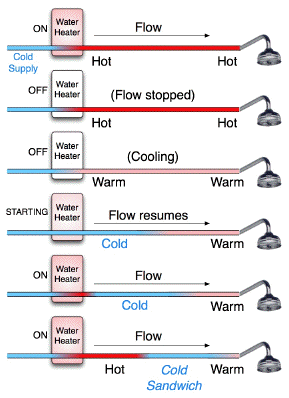 |
Details
Measure the inside diameter and the length of each pipe between your water heater and the faucet. For each length of pipe, square its radius, multiply by Pi (3.14159), and then multiply by the length. The result is cubic-inches (or cubic-feet). Add those volumes together to get the total volume of the standing water in your pipes. Then, repeat the computations, but use the smaller diameters. Multiply your current delay time by the ratio of the two volumes to compute your new delay. To this, add the time it takes the heater to get up to temperature.
| Water travel times (in seconds) per 10-feet of pipe | |||||
|---|---|---|---|---|---|
| Flow rate | Pipe inside diameter (inches) | ||||
| 0.5 | 0.75 | 1.0 | 1.25 | 1.5 | |
| 1 gal/min | 6.1 | 13.8 | 24.5 | 38.2 | 55.1 |
| 2 gal/min | 3.1 | 6.9 | 12.2 | 76.5 | 27.5 |
For example, it will take about 7 seconds for water to flow through a 1-foot-long, 0.75-inch diameter pipe.
| ||||||||||||||||||||||||||||||||||||||||||||||||||||||||||||||||||||||||||||||||||||||||||||||||||||||||||||||||||||||||||||||||||
To measure the delays due to the heater internals and the water in the pipes after you have installed your tankless heater, go to the water heater, grab hold of the hot water pipe leaving the heater, and have somebody turn on the faucet. Write down the times when you feel the pipe getting hot and when your helper shouts out that the faucet is running hot. From this you can compute both delays. You cannot do much about the internal delay, but you can change the pipe diameters (local building codes permitting) to reduce the pipe delay.
A side effect of reducing the pipe diameter will be lower pressure at the faucet, especially if you are using two faucets at the same time that share part or all of the same pipe. So, consider this solution in light of your own installation and usage patterns.
Tankless Water Heater Summary:
Pros:
- Higher efficiency; lower long-term costs.
- No continuous pilot light (no wasted gas).
- Only runs when water is flowing (quieter).
Cons:
- Longer time to get hot water.
- Small electric heaters restrict the flow rate to relatively low values (compared to gas units).
- Lower maximum flow rate before water is only warm (e.g., there's a multiple faucet limit).
- The "cold water sandwich" (see above).
- Lowering the flow rate might cause the heater to turn off, but you won't know that happened until the water turns cold.
- If your electrical power fails, you won't get any hot water.
Post Installation Improvements
It was frustrating to be turning down a faucet and discover 20 seconds later that the heater had turned off because the flow rate fell below the minimum. So, I installed sensors on the water heaters that operate indicators near the faucets showing if the heater is on or off. This allows the flow to be set as low as possible but still keep the water hot.
These improvements involve custom-built electronic sensors and indicators.
Sensors: The problem is finding a point to detect whether the heater is on or off.
- Electric heaters: I connected a Radio-Shack "Power-Flash" interface module to the heater element.
This should only be attempted if you are
familiar with electrical circuits.
- Gas heaters: These heaters are very complicated. There's no convenient point for an electrical connection that will detect the burner state. So, I mounted an infrared detector in the little window that allows you to see into the burner. I built a Darlington amplifier for the detector and wired that to a Radio-Shack "Power-Flash" interface module.
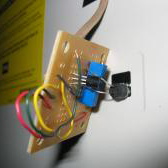
| 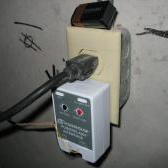
| 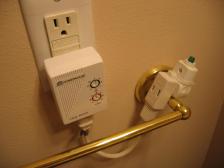
| 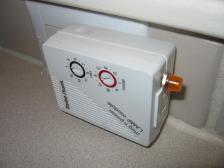
|
| IR sensor and amplifier | Interface module (1 of 2) | Indicator 1 | Indicator 2 |
Actual Results, Years Later (November, 2015)
I've been tracking our gas bills every month, starting about five years before installing the water heaters and for another five years (and counting) afterwards. Here's a chart showing the summer months:
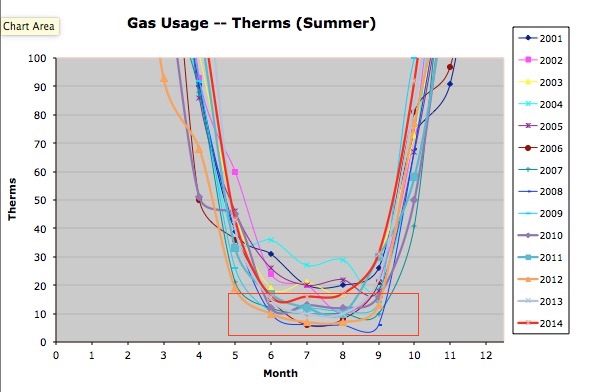
Notice the lines appear to bunch into two groups during June, July, and August (when our only gas usage is by the water heaters). As if by magic, the top group are the five pre-tankless years and the bottom group are the years since. Obviously, there's some savings there. Here are ballpark estimates based on the graph:
- July usage before tankless: 20 CCF (hundred cubic feet)
- July usage after tankless: 10 CCF
- Average savings per month: 20-10=10 CCF
- Savings per year: 120 CCF
- Our current energy rate is about $0.85 per CCF.
- That's about $100 per year (for both heaters, combined).
Links to More Information
Tankless Water Heater - What You Need to Know (About.com)
Tankless 101 A tutorial for the homeowner and the professional (profitableplumbing.com)
Homeowner FAQs and Considerations More homeowner FAQs and advice (totalvegasrealestate.com)
https://www.mge.com/saving-energy/business/bea/article_detail.htm?nid=1776 (Madison Gas & Electric)
Some articles at the following links assume tankless heaters have a standing pilot (e.g., "But gas-fired tankless heaters are only available with standing pilot lights"). However, modern tankless, such as the Rannai units described above, have an electronic ignition.
http://energy.gov/public-services/homes/water-heating (U.S. Dept. of Energy)
http://hes.lbl.gov/hes/makingithappen/no_regrets/waterheatertankless.html (Home Energy Saver, US DOE)